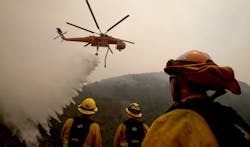Dec. 14--San Diego is spending $33 million on a cutting-edge firefighting helicopter and a new hangar at Montgomery-Gibbs Field to house the new chopper and two older models the city operates.
City officials said the new chopper will play a key role in helping San Diego fight larger and more aggressive wildfires that California has begun experiencing as climate change accelerates.
The City Council this week unanimously approved $20 million for the new chopper, which is capable of dropping nearly three times the water of the city's current choppers -- 1,000 gallons versus 375 gallons.
The council also approved spending just under $13 million on the hangar, but that approval came after a contentious debate about whether the money would be better spent on building fire stations in neighborhoods with weak response times.
A consultant's report released in the spring recommended San Diego prioritize new stations to fill geographic coverage gaps in six areas of the city with response times that exceed national standards.
Based on that report, the city's independent budget analyst recommended the council consider spending the money earmarked for the hangar on a new station or some other public safety priority.
"While the project would serve the needs of the city, the helicopter hangar would not move the city toward its previously identified high priority goal for the Fire-Rescue Department of reducing emergency response times in areas of the city where service level standards are currently not being met," Chris Olsen, fiscal and policy analyst for the IBA, told the council during a Wednesday hearing.
Three council members agreed and lobbied their colleagues to delay a decision until next year on the hangar money, which is part of a $23 million payout the city is receiving under a 1998 national settlement with tobacco companies.
Council President Myrtle Cole said boosting coverage in neglected areas of the city is more important than a hangar for helicopters.
"With the increasing number of fires and emergencies, it is important that our communities have equity in service," she said.
Fire Chief Brian Fennessy said fire stations remain the highest priority for the city, but that the tobacco money must be spent within three years and the hangar is the only shovel-ready project the department has right now.
A fire station planned for Fairmount Avenue near City Heights, the city's highest priority station, can't be built that quickly because of environmental hurdles on land the city recently bought for the station, he said.
The chief also emphasized that the hangar is a crucial project.
"Aside from the new helicopter, I've got $16 million worth of aircraft sitting out in the weather," said Fennessy, referring to the two choppers the city already owns. "This is a citywide response vehicle that needs to be housed."
Councilman Scott Sherman agreed, saying it would be shortsighted not to properly house the $20 million helicopter.
"To me, that would be like going down to a car lot and buying a Lamborghini and taking it home and throwing it out on a dirt lot," Sherman said.
The council voted 7-2 in favor of funding the hangar project, but added stipulations that city officials create a timeline for new fire stations by January and a funding plan for the Fairmount station by February.
Fennessy said having three choppers instead of two would ensure the city has at least two available at all times, explaining that the choppers are frequently out of service for maintenance and repairs.
The new helicopter is called a Firehawk, which Fennessy said is quickly becoming the standard for attacking wildfires.
The Los Angeles County Fire Department owns three and is buying two more, and the California Department of Forestry and Fire Protection agreed last week to buy 12, he said.
In addition to dumping water on wildfires, it can conduct hoist-air rescues, shoreline rescues, swift-water rescues, night vision goggle operations, patient transports, vehicle rescues, large animal rescues and infrared detection.
Fennessy said the city needed to upgrade its choppers in the face of greater wildfire danger.
"Climate change is causing year-round fire seasons," he said. "Fires are spreading more rapidly and becoming larger, and we're seeing greater loss of life and structures than we've ever seen before."
The city's existing firefighting helicopters are made by Bell.
The first was manufactured in 1980 and bought by the city in 2005, just over a year after the notorious 2003 Cedar Fire made clear the region lacked adequate resources to fight wildfires.
The second was bought new in 2008, shortly after the 2007 Witch Fire. Fennessy said it's more effective and reliable and gets much more use by firefighters than the 1980 model, but noted it has the same water capacity -- 375 gallons.
The purchase of the chopper would include a $9.8 million initial payment and then payments including interest averaging $2 million per year through 2029. It would not be eligible for the tobacco money because it's not a construction project.
___ (c)2017 The San Diego Union-Tribune Visit The San Diego Union-Tribune at www.sandiegouniontribune.com Distributed by Tribune Content Agency, LLC.






